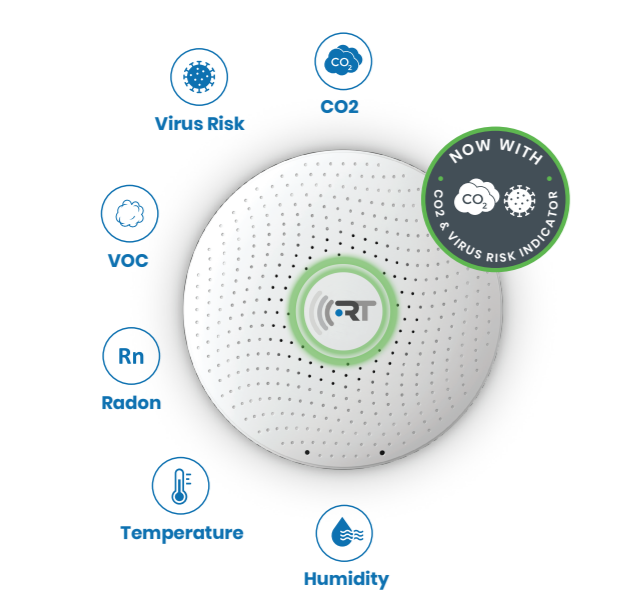How RT Smart Data monitors your air quality to detect virus risk
How does airborne virus spread indoors?
The most common routes of transmission for viruses are via microscopic airborne droplets, larger droplets through sneezing or coughing, and surface contact. Distancing and cleaning habits can help mitigate two of those, but what about the tiny droplets we can’t see? These microscopic droplets can stay viable for long periods of time and travel through a building.
How does it work?
The Virus Risk Indicator looks at four factors of airborne virus risk to rank your risk level out of 10. These four factors use data based on three existing sensors in our flagship product Wave Plus Air Quality Monitor: CO2, Temperature and Humidity.
4 Factors
1: Virus survival rate
How long airborne microdroplets remain viable in the air.
2: Room occupancy
Rooms with a dense occupancy increase the chance of people breathing each other's breaths which can spread virus and bacteria.
3: Ventilation rate
The risk of airborne virus transmission is affected by the dilution of the air, not just recycling of air.
4: The body's natural defences
The effectiveness of our immune system to defend against airborne virus is affected by temperature and humidity.
By monitoring your air quality you can:
Understand your Risk
By monitoring the air you can understand areas in your building that have elevated airborne virus transmission risk. Different areas might need a different approach and data is needed to plan preventive measures.
Take Action
Know what to do and where using virus risk insights and risk analysis reports in the Dashboard. With continuous monitoring you can check that your methods are working, and receive alerts when your virus risk creeps up.
Put people at ease
Indoor air quality monitoring helps you keep in line with new and emerging recommendations. Do what you can to create a safe environment for building occupants, and show them that you’re prioritizing their health
What do my virus risk levels mean?
1-4 Normal level: You should aim to keep your risk at this level where the chance of airborne virus transmission is lowered.
4-7 Action level: The point at which you should take action and follow some of the suggested insights in the dashboard to lower your risk back to Normal levels.
7-10 Warning level: Virus transmission risk is high. Action should be taken straight away using the tailored suggestions in the dashboard.
For more information contact Martin Wright by email: martin.wright@rtsmartdata.com

